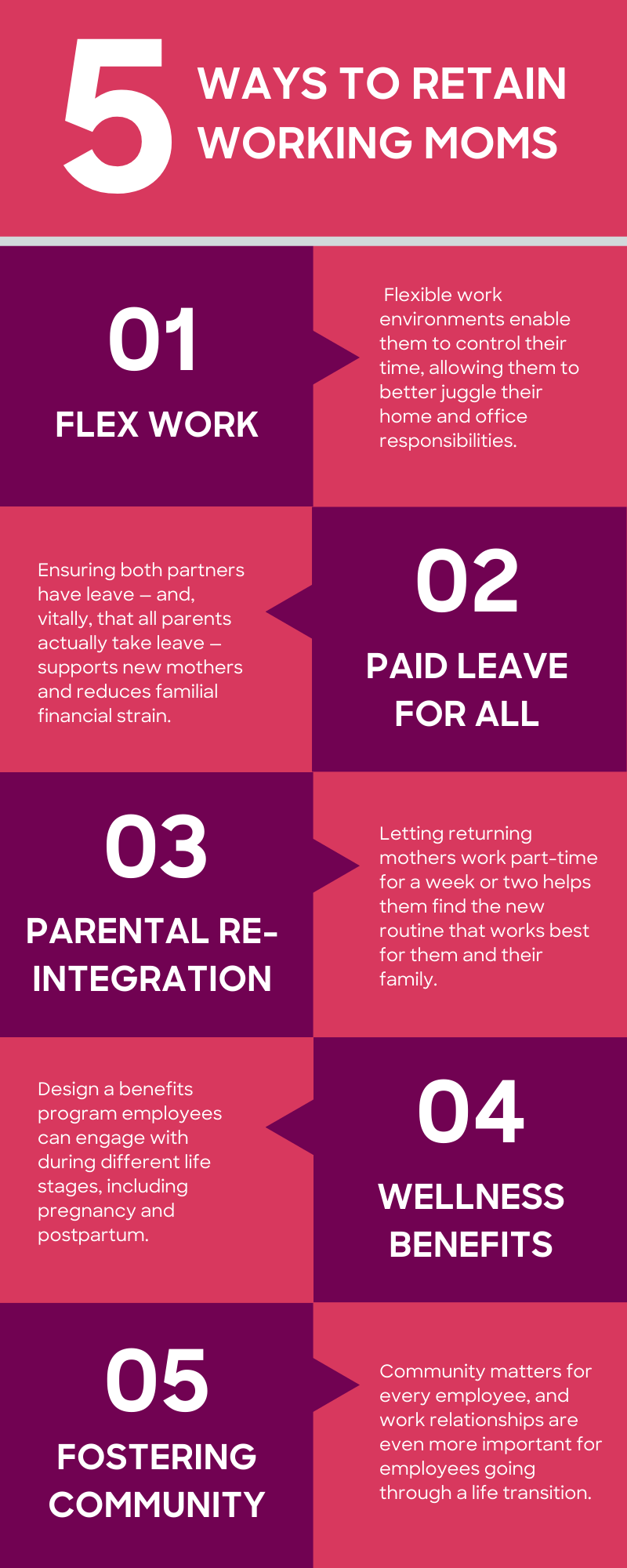Five Ways Employers Can Retain Working Moms
Last Updated Jan 28, 2025

Becoming a mother is a profound life change. It can also have a profound impact on a woman’s career: Half of working moms say being a mother makes it harder to advance their career, and an estimated 43% of first-time mothers leave the workforce.
These are troubling statistics for any organization. They speak to a labor market where worker’s talents are underutilized, great leaders are passed over, and companies have costly leaks in their talent pipeline.
Fortunately, these figures are not inevitable. Structural supports for mothers can keep them on staff and advancing within an organization. And these changes are not about lowering standards or providing favors — this is about building a world of work that actually works for people of any identity.
Based on my experiences as an HR leader at Wellhub and as a working mother, here are five tools I know companies can use to improve retention of working moms, bringing us one step closer to an inclusive world of work.
- Create a Flexible Work Environment
Women shoulder a disproportionate amount of caregiving responsibilities, even if they are not a mother. As the Center for American Progress put it: “Regardless of age or parental status, women were a staggering five to eight times more likely to experience a caregiving impact on their employment in 2022.” When inflexible work conditions force women to choose between family and career, they often choose family.
But companies don’t have to force women to make this tradeoff. Flexible work environments enable them to control their time, allowing them to better juggle their home and office responsibilities. A variety of policies support flex work — including remote work, customizable hours, and generous time off policies — so companies can find what mix best suits their industry while still attracting and retaining women to their organization.
Personally, this flexibility has allowed me to maximize my efficiency work output while also meeting the needs of my family, including breastfeeding and pumping. I chose to breastfeed my son, and wished to be able to do this for the first year of his life. I have no doubt that if I were unable to work remotely and had to carry all of my supplies to and pump in an office every day, I would have given up much before my goal. Additionally, the freedom to block my calendar off for dinner, bath, and bedtime routine allows me to spend uninterrupted quality time with my son, even if I need to sign back in to finish up some work after he is asleep.

- Provide Paid Leave — for Everyone!
At Wellhub, we feel it is important to provide paid leave for all new parents.
Birth parents in the United States are provided 20 weeks of fully paid leave, featuring a two week ramp back period for weeks 19 and 20 (more on that later!). But that’s only the start of our parental leave policy. It is important to us that we provide substantial time off for every type of parent — all genders, birth, adoptive, and foster parents. We strive to create and support a culture where both partners contribute equally at home and it’s normal for people of every gender to take time off from work when they welcome new additions to their family.
Ensuring both partners have leave — and, vitally, that all parents actually take leave — supports new mothers and reduces familial financial strain. It also lessens the perception of the “motherhood penalty,” where women are seen as less committed to work due to the time they take to care for their children. Recent data shows this view persists in today’s workplace: Only 2 out of 5 of male managers in a 2023 IBM-Chief joint survey said women with dependent children are as dedicated to their jobs as women without children. When men and women take the same amount of time off of work when a new child enters their family, this bias can be reduced.
I very clearly remember when my son turned 12 weeks old. I couldn’t imagine having to go back to work and place his care with someone else when he was still so young and small. At that moment, and still today, I was extremely thankful that I did not have to focus on anything but him for another 8 weeks. Generous paid leave policies increase the rate that women stay in the workplace after giving birth. For example, when Google (now Alphabet) increased paid maternity leave from 12 to 18 weeks in 2007, the rate at which new mothers quit dropped by 50%.
- Support Parental Reintegration
Following 18 weeks off at Wellhub, I was able to take advantage of a two-week ramp back period where I worked part time while adjusting to life as a working mom. In the days and weeks leading up to my return, I was filled with anxiety about how I could balance being effective at work while also being a great mom. This was completely uncharted territory for me and I had no idea how to navigate it.
This two week period allowed me to learn what worked for me and our son before being fully back at work. Providing this small ramp back window supports mothers returning to work to find the new routine that works best for them and their family so they can return to work with confidence.
- Offer Inclusive Wellness Benefits
We all know the benefits of taking care of your physical and mental wellbeing. When designing a benefits program, it's important to remember that the way your employees engage with these benefits can look very different depending on their life stages, with pregnancy and the postpartum period being a great example.
As a lifelong athlete, it was important to me to remain active during my pregnancy, not only for the physical benefits but as a way to manage stress and engage in self care. Through Trainiac by Wellhub, I was able to find an amazing prenatal certified trainer, Melanie Payne, who safely trained me throughout my pregnancy in order to prepare for giving birth and my recovery after. Melanie’s expertise has helped me to rebuild my strength so much that I was able to complete my 7th Boston Marathon just 10 months postpartum. Any new mom can tell you that being able to retain the sense of self you had from before becoming a mother is crucial in supporting positive mental wellbeing.
- Create a Sense of Community
One of the things that became obvious to me soon after giving birth was that I was now a part of the “working mom’s club.” I was humbled and appreciative of how many other mothers at Wellhub reached out to me to congratulate me and offer words of support and encouragement following the birth of my son. We have a shared experience and understand the unique challenge of balancing motherhood and career.
Although this happened organically for me, I think that organizations can benefit from supporting their working parents through the creation of opportunities to connect and support each other. Community matters for every worker — Gallup found in 2018 that people with a best friend at work are “twice as likely to be engaged in their jobs, are better at engaging customers, produce higher-quality work, have a greater sense of well-being, and are less likely to get injured on the job.” Those relationships are even more important for employees going through a life transition.

Company healthcare costs drop by up to 35% with Wellhub*
See how we can help you reduce your healthcare spending.
[*] Based on proprietary research comparing healthcare costs of active Wellhub users to non-users.
References
- Fact sheet: The State of women in the labor market in 2023. Center for American Progress. (2023, February 6). Retrieved May 4, 2023, from https://www.americanprogress.org/article/fact-sheet-the-state-of-women-in-the-labor-market-in-2023/
- IBM. (2023, March 1). IBM and chief study finds women in leadership pipeline has hollowed out in the Middle. IBM Newsroom. Retrieved May 4, 2023, from https://newsroom.ibm.com/2023-03-01-IBM-and-Chief-Study-Finds-Women-in-Leadership-Pipeline-has-Hollowed-Out-in-the-Middle
- Kaado, B. (2023, February 21). Why having a best friend at work matters. Business News Daily. Retrieved May 4, 2023, from https://www.businessnewsdaily.com/6759-friends-at-work.html
- Menasce Horowitz, J. (2020, August 7). Despite challenges at home and work, most working moms and Dads say being employed is what's best for them. Retrieved May 4, 2023, from https://www.pewresearch.org/short-reads/2019/09/12/despite-challenges-at-home-and-work-most-working-moms-and-dads-say-being-employed-is-whats-best-for-them/
- Origin story. The Mom Project. (n.d.). Retrieved May 4, 2023, from https://themomproject.com/about
- Truong, A. (2016, January 28). When Google increased paid maternity leave, the rate at which new mothers quit dropped 50%. Quartz. Retrieved May 4, 2023, from https://qz.com/604723/when-google-increased-paid-maternity-leave-the-rate-at-which-new-mothers-quit-dropped-50
Category
Share

Nikki Salenetri is the Vice President of People at Wellhub. She joined the company in 2018 as Head of Human Resources for the United States, and now helps lead the global Wellhub team of approximately 1,200 employees across 10 countries. Before joining Wellhub, she leveraged her Masters Degree in Industrial & Organizational Psychology from New York University as an HR leader at Rodale, Equinox, and the Wall Street Journal.
Subscribe
Our weekly newsletter is your source of education and inspiration to help you create a corporate wellness program that actually matters.
Subscribe
Our weekly newsletter is your source of education and inspiration to help you create a corporate wellness program that actually matters.
You May Also Like

How HR Can Help Employees Avoid the Sunday Scaries | Wellhub
Even employees who love their jobs can experience anxiety before starting a new workweek. Learn how to help you and your team manage the Sunday Scaries.

Sabbaticals: A Comprehensive Guide for HR Leaders | Wellhub
Employee sabbaticals can reduce burnout and improve wellbeing. Leverage these best practices, policies, and procedures for implementing an impactful program.

How to Offer Mental Health Days at Work (An HR Guide) | Wellhub
Investing in mental wellbeing can deliver measurable business returns. Explore how mental health days can prevent burnout and improve productivity.